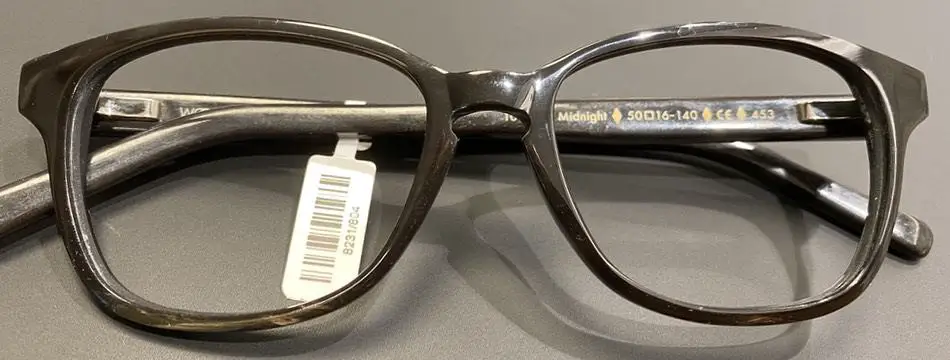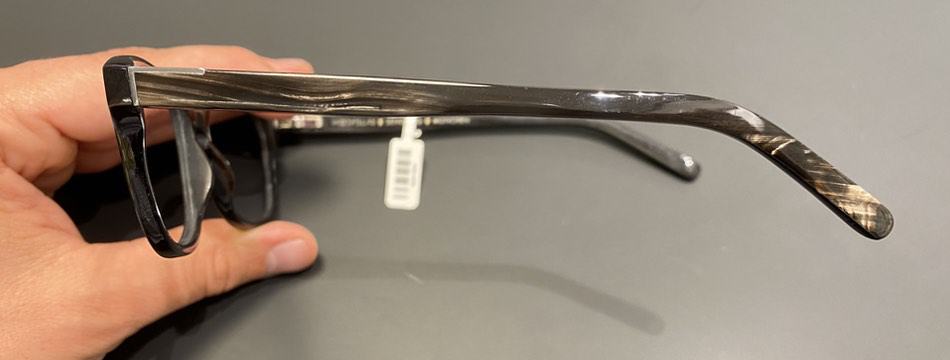Horn-rimmed glasses are still very popular with some eyeglass wearers. Here in this article you will learn more about the care, the material and even about the insertion, the glasses to understand problems.
Natural materials especially horn glasses are rather niche products and not available in every optical store. So it could be that the optician has no experience with the material. This then quickly leads to a broken eyeglass frame. The material reacts quite differently than conventional plastics used in the manufacture of eyeglasses.
Even if there are the described difficulties with horn, it is a very pleasant material to wear. Horn is lighter than most materials and directly creates a pleasant warmer wearing feeling compared to the master plastics. In addition, you have no softeners in the material that get in contact with your skin over time.
So it’s worth taking a closer look at the topic of horn glasses. Read on to learn more.

What Care Do Natural Horn Glasses Need?
The care of horn-rimmed glasses is very simple. It needs grease on a regular basis. Approximately every 2 weeks, they can oil in the evening with the finger very little linseed oil over the frame. Over night, the oil is absorbed into the horn material.
So you should rub your horn-rimmed glasses more often with an oil or a natural grease. The rule is, rather often with little, than rarely with much grease maintain.
Horn-rimmed glasses are absolutely easy to care for. You can rinse them normally with water, and then best rub dry with cosmetic wipes.
After about 4-5 years, it may be that the surface of the horn-rimmed glasses has lost some of its natural luster. In such a case, your optician can polish the horn-rimmed glasses again. But here there are big differences. In most cases, opticians polish up frames in a few minutes.
This process is not enough here. It is better to go to an optician who may make horn-rimmed glasses himself. Because these opticians usually use drums for polishing, which are very gentle on the material. In addition, it may be that the optician keeps the glasses for several days in the workshop to let the oil soak in.
Never clean horn frames in an ultrasonic bath, it is best to use a microfiber cloth for this purpose.
How Do Adust Horn Glasses?
The adjustment of buffalo horn frames is not difficult, but requires care, tact and a little more time. The reason for this is the buffalo horn, which does not expand under heat in the same way as conventional plastics used to make eyeglass frames.
Due to its naturally grown structure, it is more susceptible to cracking if not handled properly.
Eyeglasses made of horn have the property to retract to the original shape after being heated and adjusted. However, the optician can counteract this by holding the glasses in the desired position while they cool down.
Especially with natural materials, I would make sure that the glasses have a very good fit right from the start and that only minor corrections are necessary. Because each pair of glasses is unique and the grown structure can be bent but only to a certain extent.
The material must be heated very SLOWLY. For this purpose, the optician has a hot air device that he uses to heat the glasses strongly for 30- 40 seconds. This process is repeated 5-6 times. The glasses are moved evenly in the hot air stream so that the horn is heated evenly everywhere. The horn material is even heated so much that the optician cannot touch the glasses with bare hands.
Only when the glasses have become so hot, they can be adjusted for about 30 seconds.
Which Lenses Are Best Fitted Into Natural Horn Frames?
Thinner flatter lenses are better suited for use in horn-rimmed glasses. The reason for this is that thicker lenses, which may be more curved, can have more stresses. These tensions do not lead directly but a few weeks later to cracks in the material.
For this, minus lenses are more likely than thicker plus lenses. Theoretically, the frame could also be made to the curve of the lenses. However, such a process must always be discussed individually with the manufacture of horn-rimmed glasses.
If we talk about the lens material, then only plastic should always be used in combination with horn-rimmed glasses. The reason for this is that plastic lenses are less rigid compared to glass lenses. This leads to less tension.
With the lenses is also important that they do not have any tension when inserted. Normal plastic frames are incorporated so that the lens sits directly firmly in the frame. With horn-rimmed glasses, the lens should slide more loosely into the frame, otherwise there will be too much tension, which the grown structures of the horn-rimmed glasses cannot tolerate. The result is then of course cracks.

How Do Natural Horn Glasses Look Like?
As with all natural materials, the appearance of horn varies greatly. The color spectrum ranges from white tones that shimmer different to dark brown shades. Some glasses look almost black.
The grain of each horn is also quite individual. Depending on the processing method, the surface of the horn glasses gets a different appearance. It shimmers silk-matt or is polished to a high gloss. The thickness of the material is comparable to most plastic frames. They usually have a thickness of 4mm. But of course there are also thinner an thicker options available.
With very thin horn glasses you need to be a bit more cautios as those are the ones that break more easily. When somone hugs you intensely or a kid grabs your glasses cracks could happen very quickly.
This was my little summary about natural horn glasses. When it comes to manufactureing them there are still a lot steps involveld which are made by hand. This not only makes every horn glasses unique but your optician could communicate your wishes to the manufacturer. In some cases the manufacturer changes the design or the fit a little bit to produce the perfect horn glasses for you.
